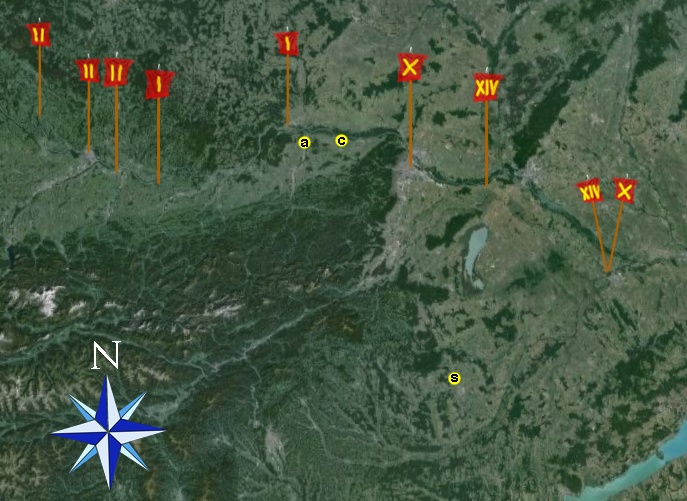
This page created 7 October 2014, and last modified: 29 July 2015 (map added)

The Lanciarii Augustenses is listed (21.20 in Ingo Maier's numbering scheme) as sixth of the eight units of legiones comitatenses under the command of the Magister Militum per Illyricum. Its shield pattern (20#10) as shown in various manuscripts, under the matching label (20.k) Lanciarii Augustenses, is as below:

The pattern features a red rim, a violet-indigo main field (more purple in B, light blue in W, and faded to pink in M), a yellow boss plus pillar beneath (both faded to almost white in W), and above the boss, a red human head (white in M). The motif of a "head over/on a stick" is very common in the Notitia, albeit not for legionary units; the only other example is also in the command of the Magister Militum per Illyricum: the Dianenses (21.17), although the Dianenses is more an example of "the exception that proves the rule", since the pillar in that case appears to be anything but.
While the name Lanciarii comes from the lancea, a spear suitable for both thrusting and throwing, this does not necessarily imply the Lanciarii Augustenses was equipped with this weapon, since the title lanciarii (or lancearii) had become the designation of elite guards in the later 3rd century; we even hear of mounted lanciarii, as attested by inscriptional evidence (AE 1981, 777) where the gravestone of one Aurelius Gaius describes him (in Greek) as an "ippeus lankiaris". There are a number of lanciarii units listed in the Notitia, some of which are obviously elite units, while some have no such indication.
The second half of the unit's name, Augustenses, would appear not to refer to an emperor ("Augustus") as might be first imagined, but instead, to a locality named Augusta, of which there were a great many in the Roman empire. One such locality that is not too far from the territorial jurisdiction of the Magister Militum per Illyricum is the fort at what is modern Harlets in Vratsa, Bulgaria, and that in the Notitia is listed as being the base (80.6, "Augustae") of a Cuneus equitum Dalmatarum under the Dux Daciae ripensis. Not so close, but more substantial, is Augusta Vindelicum (modern Augsburg, Germany), the capital of the Dux Raetiae primae et secundae, and in the Notitia, given as the base (147.2, "Augustanis") of a unit of Equites stablesiani seniores. But the most likely candidate is is no doubt Augustiana, given in the Notitia (145.23, "Augustianis") as the base of a unit of Equites Dalmatae under the Dux Pannoniae primae et Norici ripensis, since the neighbouring towns of Comagena, Lauriacum, and Savaria are also clearly the sources of three other units of lanciarii: the 98/9.134 Lanciarii Comaginenses, the 98/9.133 Lanciarii Lauriacenses, and the 98/9.028 Lanciarii Sabarienses, respectively.
Given the Lanciarii Augustenses, Lanciarii Sabarienses, Lanciarii Lauriacenses, and the Lanciarii Comaginenses all have names deriving from garrison stations under the Dux Pannoniae primae et Norici ripensis, and there are four limitanei legions under the Dux, it would appear likely that each of these four units is derived from one of the four legions under the Dux. Since Legio II Italica appears to have been headquartered at Lauriacum, it is almost certainly the progenitor of the Lanciarii Lauriacenses. Which of Legio I Noricum, Legio X Gemina and Legio XIV Gemina correspond to the other three units is less obvious.

However, looking at the locations of the legionary detachments stationed along the Danube in what is now Austria gives a reasonable indication that the Lanciarii Augustenses is most likely to derive from Legio I Noricum, since Augustiana ("a" in the above map) is most closely positioned to a detachment of that legion, while the Lanciarii Comaginenses is most likely to derive from Legio X gemina, since Comagina ("c" in the above map) is most closely positioned to a detachment of that legion, leaving the Lanciarii Sabarienses to Legio XIV gemina, which is most closely position to Savaria ("s" in the above map).

Return to the Notitia alphabetical unit list page.
Return to my Notitia index page.